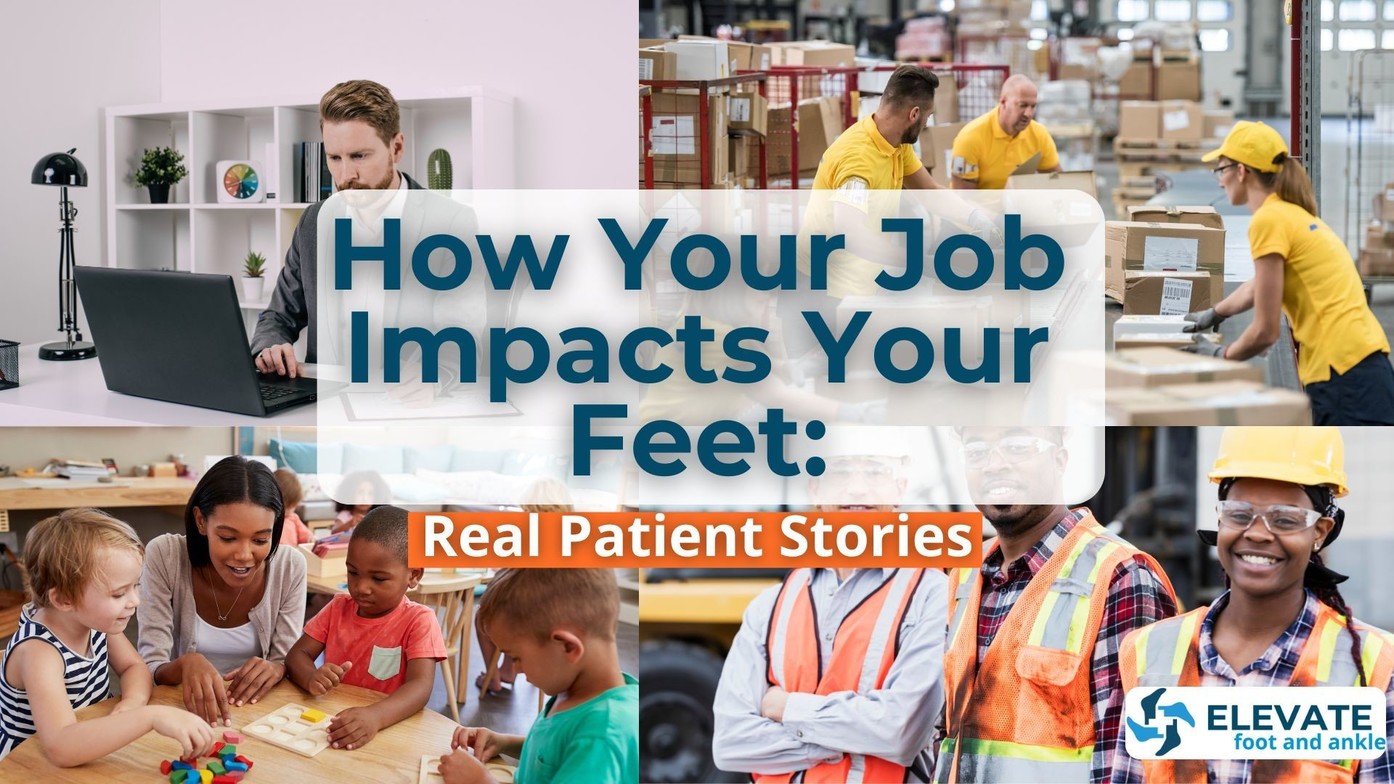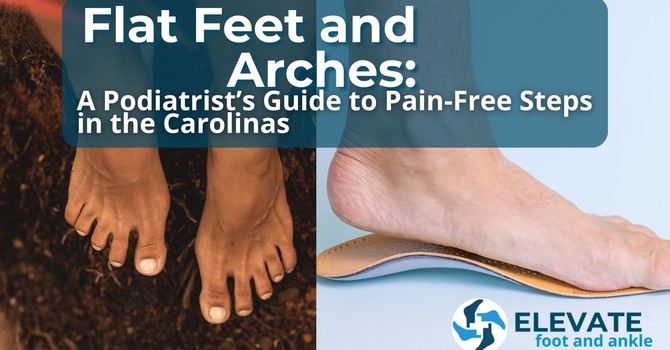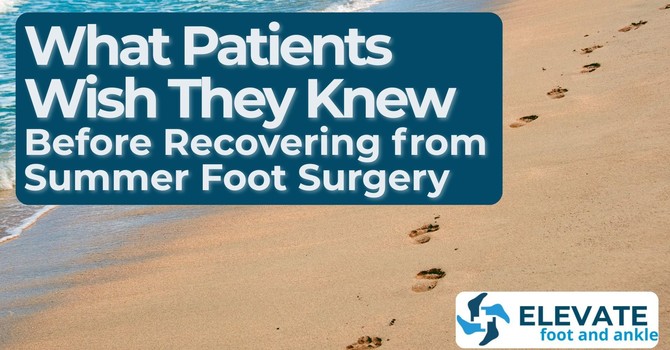
Summer in the Carolinas is a time for action. Whether you’re serving tables in Myrtle Beach, working at a marketing agency in Charlotte, or building at a construction site near Asheville, you stay busy as the Carolinas continue to grow. At Elevate Foot and Ankle, we see how occupations can take a toll on your feet, particularly during the summer months, and we want to help workers across the region enjoy the summer season and stay pain-free!
As a podiatrist who’s treated countless patients across the region, I’ve also felt the strain of long clinic days on my own feet. In this post, I’ll share my insights about how your job can affect your foot health, and I’ll also share stories from patients to help you learn how others have dealt with job-related foot pain.
My Story: A Podiatrist’s Aching Feet
Being a podiatrist, I’m often working long hours. Despite my best efforts, including wearing proper footwear and taking care of my foot health, I can experience fatigue just like my patients.
Standing on hard floors, pivoting between exams, and the day-to-day activity of running a podiatric practice can sometimes trigger heel pain. If I don’t make my feet a priority, I often experience aching after long shifts.
How My Experience Shapes Our Podiatry Practice in the Carolinas
While no one likes foot fatigue, including me, my experience alongside my education and training have given me the ability to empathize with people from all different backgrounds across the Carolinas. When a patient comes to me concerned about a foot health issue, I’m able to identify because I’ve dealt with my share of foot problems over the years.
At Elevate Foot and Ankle, I use these experiences to help our patients reduce the impact of foot issues and recover after job-related foot injuries. Below are some common trends I’ve seen in different industries along with some solutions to help you stay productive and ward off foot concerns:
Jobs and Their Foot Health Challenges
Hospitality Workers
Servers dashing across restaurant floors in coastal towns like Myrtle Beach face constant foot strain, especially during the summer months when tourists demand fast service. The fast-paced environment, combined with unsupportive shoes (think slip-resistant but flimsy clogs), often leads to plantar fasciitis or arch fatigue.
One patient, *Sarah, a bartender at a busy beachfront spot, came to us with burning heel pain after a month straight of 10-hour shifts. Her thin-soled shoes offered no shock absorption, exacerbating her condition.
Solution: Choose shoes with a rigid shank and cushioned insole, even if they’re not the trendiest. Take micro-breaks to stretch your calves as well. For example, try 30 seconds of wall pushes every few hours. If pain persists, book a visit with Elevate Foot and Ankle for personalized treatment.
Teachers
Teachers spend hours standing, pacing classrooms, or crouching to assist students. I recently spoke with *Michael, a middle school teacher in Fayetteville, who told me that he loves teaching students, but he’s happy the school year is over.
Michael had developed Achilles tendonitis from years of standing on concrete floors, and he was reeling from the pain daily. Through a telehealth visit, we discovered that the repetitive strain of shifting weight worsened his tendon inflammation.
Solution: I encourage teachers to use anti-fatigue mats if your classroom allows, and opt for supportive sneakers with a slight heel lift to reduce Achilles strain. At home, try rolling a frozen water bottle under your foot for 10 minutes to ease inflammation. At Elevate Foot and Ankle, we offer tailored stretching plans through our innovative telehealth technology to keep you moving comfortably.
Construction Workers
Construction workers navigate uneven terrain and carry heavy loads all the time, putting immense pressure on their feet. Unfortunately, this leads to foot pain quite often.
As an example, I recently spoke with *Javier after he complained of pain in the balls of his feet (metatarsalgia) while working on a Hurricane Helene cleanup project near Asheville. Javier’s issue was due to his steel-toed boots lacking proper forefoot cushioning. The constant pounding on hard surfaces inflamed his metatarsal heads, leading to daily pain and lower productivity on the job site.
Solution: For construction professionals, I often suggest investing in work boots with thick, cushioned insoles and a wide toe box to prevent crowding. Rotate between two pairs of boots to let them dry out, even if you aren’t working in damp conditions. Daily wear doing hard physical labor can lead to sweat, and this can increase the odds of developing fungal infections in our humid Carolina climate.
Healthcare Professionals
Nurses and doctors, like my colleagues in Columbia, SC, spend long shifts walking hospital corridors or standing during procedures. I’ve treated nurses with stress fractures from repetitive impact on hard floors, often worsened by worn-out shoes. One nurse, *Emily, ignored her foot pain until a hairline fracture sidelined her for weeks.
Solution: To reduce the potential for foot pain and injuries while working in healthcare, replace shoes every 6-8 months or after 500 miles of wear. You should also check the soles for uneven wear patterns. You might also benefit from the use of compression socks to reduce swelling during long shifts. If you’re feeling persistent pain, schedule a virtual visit in North and South Carolina
with Elevate Foot and Ankle.
Office Workers
Even seated jobs can harm your feet. Prolonged sitting with poor posture can reduce circulation, leading to swollen ankles or plantar fascia tightness. A patient, *Lisa, a Raleigh accountant, developed heel spurs from alternating between sitting for hours and brief bursts of walking in unsupportive flats during tax season.
Solution: Elevate your feet under your desk when possible, and do seated ankle circles (10 per direction) hourly to boost circulation. Choose low-heeled shoes with arch support for office days. For personalized relief, Elevate Foot and Ankle offers foot care in the Raleigh area as well as throughout North and South Carolina.
Summer-Specific Tips for Foot Health
Although many of the solutions to patient foot concerns mentioned above apply year ‘round, there are a few things I’d like to mention that apply directly to foot care during the summer in the Carolinas. July’s heat and humidity in North and South Carolina can amplify job-related foot stress, so it’s a good idea to be extra-prepared for summertime threats to your foot health.
For outdoor workers, sweat-soaked shoes can lead to blisters or fungal infections. Swap socks midday if possible, and use absorbent foot powder.
For indoor workers, air-conditioned environments can dry out skin, causing cracks, particularly if you’re wearing shoes that expose your toes or heels. Apply moisturizer like urea-based cream at night, but don’t spread it between your toes to ward off fungal infections.
Across all jobs, stay hydrated to reduce swelling, aiming for 8-10 glasses of water daily. If you’re feeling like switching things up, consider infusing with local summer fruits like peaches from South Carolina.
When to Seek Help from Elevate Foot and Ankle
Your job shouldn’t cost you your foot health. Book an appointment with Elevate Foot and Ankle if you notice:
- Pain lasting more than a few days, especially with swelling or redness
- Numbness or tingling, which could signal nerve compression
- Difficulty bearing weight, a sign of potential fractures or ligament issues
We offer flexible scheduling, including afterhours appointments, right from the comfort of your own home. There’s no need to look for a local podiatrist nearby when you can visit with Dr. Lanier with no travel required.
Schedule Your Virtual Visit With Our Podiatry Practice Today!
Struggling with foot pain from work? Schedule a visit with Elevate Foot and Ankle today. Book online now to get lasting relief with no travel and no hassle. At Elevate Foot and Ankle, we’re taking foot care to the next level!
*Names have been changed. All depictions of patient experiences represent an amalgam of
common patient healthcare concerns and treatment options.
Dr. Thurmond Lanier
Contact Me

